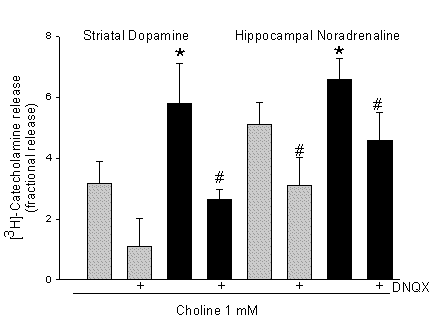| pA2 online © Copyright 2004 The British Pharmacological Society |
105P
University of Bath Summer Meeting July 2004 |
|
Nicotinic stimulation of striatal dopamine and hippocampal noradrenaline release: effects of chronic nicotine J. Barik and S.Wonnacott Dept. Biology & Biochemistry, University of Bath, Bath |
|
Presynaptic nicotinic acetylcholine receptors (nAChR, Wonnacott, 1997) modulate neurotransmitter release and could contribute to nicotine addiction. The aim of this study was to characterize the modulation of [3H]-dopamine (DA) and [3H]-noradrenaline (NA) release, respectively from striata and hippocampi and examine the effects of nicotine treatment and its withdrawal. Slices from brain regions of male Sprague-Dawley rats (250-350g) were prepared using a McIlwain tissue chopper. Catecholamine release was assessed using a 96 well assay (Puttfarcken et al., 2000).
In naive rats, the nicotinic agonist anatoxin-a (AnTx) evoked DA release (n=3) that was biphasic (EC50 values of 89 nM and 6.7 µM). AnTx-evoked NA release (n=4) best fitted a single site model (EC50 = 1.44 µM). Selective activation of ![]() 7 nAChR by choline evoked DA and NA release with an inverted U shape profile, reaching a peak stimulation at 5mM choline. To test the involvement of a glutamatergic component of the response, AnTx dose response curves were conducted in the presence of 800 µM kynurenic acid; the maximal DA and NA responses were inhibited respectively by 28.8 ± 10.8% (n=4) and 23.8 ± 10.7% (n=4, P<0.05 different from control, Student’s t-test ). A similar inhibition was shown using the selective AMPA/Kainate antagonist DNQX .
7 nAChR by choline evoked DA and NA release with an inverted U shape profile, reaching a peak stimulation at 5mM choline. To test the involvement of a glutamatergic component of the response, AnTx dose response curves were conducted in the presence of 800 µM kynurenic acid; the maximal DA and NA responses were inhibited respectively by 28.8 ± 10.8% (n=4) and 23.8 ± 10.7% (n=4, P<0.05 different from control, Student’s t-test ). A similar inhibition was shown using the selective AMPA/Kainate antagonist DNQX .
Following 14 days treatment with nicotine (4mg/kg/day), no changes were observed in DA or NA release evoked by AnTX (1 or 25 µM) or choline (1 mM). However, after 3 days withdrawal, choline 1mM responses were significantly enhanced (figure 1). Blockade of choline-mediated release by DNQX was similar after chronic nicotine administration (figure 1) indicating a lack of effect of the nicotine treatment at non NMDA glutamate receptors.

Figure1: [3H]-DA and [3H]-NA release in response to choline 1 mM (in presence or absence of DNQX) at 3 days withdrawal time point, following 14 days infusion of nicotine (4mg/kg/day), closed bars, or saline, grey bars. *P<0.05, #P<0.05, significantly different from saline control, or respective control (n=6, Student’s paired t-test).
These data suggest that theWonnacott S. (1997) Trends Neurosci. 20; 92-98
Puttfarcken S. et al. (2000), Neuropharmacology. 39; 2673-80
Supported by European Commission Research Training Network Grant